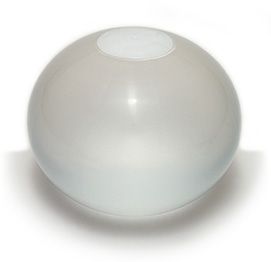Less than a month after FDA alerted doctors of patient deaths related to balloon-based obesity procedures, a newer version of Apollo’s Orbera balloon has been approved in Europe.
September 6, 2017

Apollo Endosurgery's Orbera365 weight-loss balloon works the same way as the original Orbera device, except it is designed to stay in the patient's stomach for 12 months, twice as long as the previous version.
Apollo Endosurgery said it has received CE Mark approval to sell its Orbera365 weight-loss system in Europe, doubling the amount of time the balloon stays inflated in the patient's stomach. The approval comes less than a month after FDA alerted doctors of patient deaths associated with obesity balloons made by Apollo and ReShape Medical.
The news deflated Apollo's stock (NASDAQ: APEN), as shares sold off nearly 26% after FDA published the letter, but the Austin, TX-based company was quick to do damage control. Apollo defended the Orbera intragastric balloon during a conference call, noting that the device actually has a "very low mortality rate" of 0.01%.
Originally, the Orbera balloon was removed from the patient's stomach after six months, but Orbera365 doubles the indwell period to 12 months, hence the name. Apollo said it will launch the new device in European countries where the CE Mark is recognized starting in the fourth quarter.
The newer version of the balloon could potentially help patients achieve better weight loss results, according to Alfredo Genco, a professor at Sapienza University in Rome, Italy who has been treating obesity with Orbera since 1999.
"In my experience the longer the treatment, the more weight patients tend to lose," Genco said. "Actually, using Orbera365, our patients will now have twice as long to change their eating behaviors and ensure long-lasting results."
Apollo Endosurgery CEO Todd Newton said the CE Mark approval of Orbera365 involved a comprehensive review of clinical and non-clinical data by "a regulatory body in a market with deep understanding and experience with intragastric balloon therapy."
Newton also said the approval serves as a "strong testimony of the relevance and significance of more than a decade of the Orbera system's safety and efficacy data as supported by more than 277,000 distributed implants and 230 published peer-reviewed papers.
Like the original device, Orbera365 is considered an incision-less, non-surgical weight loss solution for adults suffering from obesity who have not had success with diet and exercise or pharmaceutical interventions.
During an endoscopic procedure, a deflated balloon is placed into the stomach through the mouth and then filled with saline until it is about the size of a grapefruit. The procedure typically takes about 20 minutes and the patient is usually able to go home a few hours later. The Orbera365 balloon is deflated and removed a year later during another endoscopic procedure.
Once the balloon is in place, the patient works with their physician and their staff in a formal lifestyle modification program to meet their long-term weight loss goals. Coaching takes place over 12 months while the balloon is in place. The program is designed to help the patient develop sustainable, healthy habits that will help keep weight off over time.
FDA recently alerted gastrointestinal surgeons that five patients died soon after having a procedure to receive a liquid-filled intragastric balloon to treat obesity since the devices were approved. Four of the patients had received the Orbera balloon, and one patient had received the ReShape Integrated Dual Balloon System made by San Clemente, CA-based ReShape Medical. Both balloon systems were among a rash of obesity treatment devices FDA approved in 2015.
The agency said in its letter that it does not know the root cause or incidence rate of patient death, nor has it been able to "definitively attribute" the deaths to the devices or the procedures for these devices. The alert was a follow up to a February letter the agency sent to providers that recommended close monitoring of patients with obesity balloons for the potential risks of acute pancreatitis and spontaneous over inflation. Since that time, both Apollo and ReShape have revised the product labeling of the devices to address these risks.
During its conference call last month, Newton revealed that a total of 21 Orbera patients died while the balloon was in their stomach between January 2006 and March 31, 2017, which includes clinical trial patients. During this same period, Newton said, more than 277,000 Orbera balloons have been distributed, making the mortality rate less than 0.01%. That is especially low, he said, compared to other interventional treatments for obesity, including laparoscopic gastric banding.
Apollo inherited both the Orbera balloon and the Lap-Band device through its $110 million acquisition of Allergan's obesity intervention division in 2013.
Amanda Pedersen is Qmed's news editor. Contact her at [email protected].
[Image credit: Apollo Endosurgery Inc.]
About the Author(s)
You May Also Like




